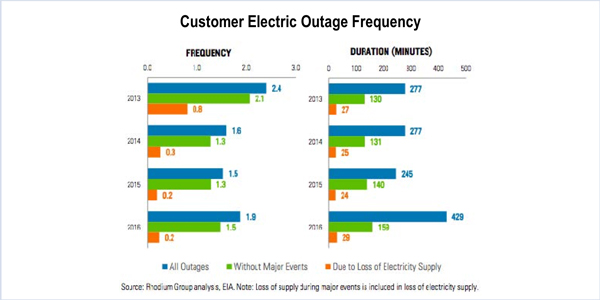By Tom Kleckner
With the deadline for filings in FERC’s resilience docket looming, two aides to former FERC Chairman Pat Wood III last week sought to reset the definition — saying resilience is about transmission and distribution, not generation.
In a report funded by the Natural Resources Defense Council and the Environmental Defense Fund, Alison Silverstein and Rob Gramlich say resilience should be measured from the customers’ perspective: the number of outages (frequency), customers affected per outage (scale) and length of time before restoration (duration).
“Customers pay the ultimate price for power outages, whether through their electric bills or their own personal losses and expenditures,” says the study, whose third author is Michael Goggin, who worked with Gramlich at the American Wind Energy Association and has since joined Gramlich’s consulting firm.
Silverstein, the former senior energy policy advisor to Wood, made headlines last year when, after helping coauthor the Department of Energy’s grid study, she denounced DOE Secretary Rick Perry for using it as a pretext for price supports for struggling coal and nuclear plants. (See Author of DOE Grid Study Disputes Recommendations.)
The DOE NOPR sought “resilience” payments to power plant with 90 days of fuel on site.
In rejecting the NOPR in January and initiating the resilience docket, FERC offered its own definition of the term: “The ability [of the grid] to withstand and reduce the magnitude and/or duration of disruptive events, which includes the capability to anticipate, absorb, adapt to and/or rapidly recover from such an event.”
RTOs made filings in the docket in March. Comments on the RTO filings are due May 9 (AD18-7). (See RTO Resilience Filings Seek Time, More Gas Coordination.)
The Silverstein-Gramlich-Goggin report was filed in the docket Tuesday. [Editor’s Note: RTO Insider will have coverage of the filings later this week.]
“I’m a customer, you’re a customer. We operate the grid for the customer, not just for our jollies,” said Silverstein, in an interview. “It seemed to me that if the point of preventing outages is protecting the customer, as NERC and others assert, we should look at the most effective ways of measuring resilience.”
The report notes the vast majority of outage events occur at the distribution and transmission levels because of weather events — which has only led customers to expect more outages.
The authors cite a Rhodium Group study that found less than 0.1% of customer-outage minutes in 2012-16 were caused by generation shortfalls or fuel supply issues. The study found most outages can be attributed to routine causes such as local storms, vegetation, squirrels and equipment problems, with high-impact, low-frequency events such as hurricanes and winter storms causing about half of customer outage-minutes.
“We cannot prevent and mitigate all the hazards and threats that cause outages, and we can mitigate some but not all of their consequences,” the authors write. “So which risks should we take, what level of resilience and mitigation cost are we willing to bear and how should we choose among resilience measures?”
The paper doesn’t answer the risk question, but it does offer a path for “assessing and selecting resilience regulatory policy options.” The report suggests regulators and stakeholders ask how each remedy “might reduce the frequency, magnitude and duration of customer outages relative to the entire scope of customer outages, not just those resulting from generation- or transmission-level causes.”
In attacking the problem, Silverstein said she borrowed from the Rocky Mountain Institute’s co-founder and chief scientist, Amory Lovins, who has said you can solve the energy problem by enlarging it. By carving problems into bite-sized chunks, Lovins has said, “you don’t have a big enough design space to have enough options, degrees of freedom and synergies.”
“There’s a big difference between generation resilience and the resilience of the power system and resilience from customers’ perspective,” Silverstein said. “When you look at resilience from the customer’s perspective, there’s a whole lot of ways to solve the problem quickly. If I spend a fortune on reducing generation failures, that’s a whole lot of money that could have been spent on tree trimming or strategic spare equipment. Tree trimming and situational awareness are not addressed by a generation resilience proposal.”
Because most outages occur at the distribution level, Silverstein, Gramlich and Goggin write, “it logically follows that measures that strengthen distribution and hasten recovery would be highly cost-effective.”
One example of this would be mobile substations, which proved invaluable during Hurricane Harvey’s restoration effort. Other examples include hardening distribution poles, physical security, outage-management systems, mutual assistance, and emergency planning and drills.
Silverstein said this will become even more important as severe weather events continue to increase in the years ahead. According to the report, the United States weathered 16 “disaster events” last year, each incurring at least $1 billion in damages. Most of the events damaged some electric system infrastructure and caused service disruptions, totaling more than $350 billion in damages.
“We really need to take that threat seriously and think about how to design power system architecture and assets for the long-term threat,” she said. “A lot of the designs today were developed in the early 1900s. The weather is going to be a lot more severe and meaner 10, 20 and 30 years in the future. We designed the grid for Ozzie and Harriet weather. What’s coming at us is Mad Max.”








